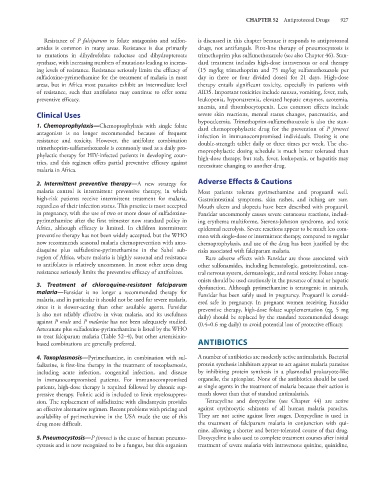Page 941 - Basic _ Clinical Pharmacology ( PDFDrive )
P. 941
CHAPTER 52 Antiprotozoal Drugs 927
Resistance of P falciparum to folate antagonists and sulfon- is discussed in this chapter because it responds to antiprotozoal
amides is common in many areas. Resistance is due primarily drugs, not antifungals. First-line therapy of pneumocystosis is
to mutations in dihydrofolate reductase and dihydropteroate trimethoprim plus sulfamethoxazole (see also Chapter 46). Stan-
synthase, with increasing numbers of mutations leading to increas- dard treatment includes high-dose intravenous or oral therapy
ing levels of resistance. Resistance seriously limits the efficacy of (15 mg/kg trimethoprim and 75 mg/kg sulfamethoxazole per
sulfadoxine-pyrimethamine for the treatment of malaria in most day in three or four divided doses) for 21 days. High-dose
areas, but in Africa most parasites exhibit an intermediate level therapy entails significant toxicity, especially in patients with
of resistance, such that antifolates may continue to offer some AIDS. Important toxicities include nausea, vomiting, fever, rash,
preventive efficacy. leukopenia, hyponatremia, elevated hepatic enzymes, azotemia,
anemia, and thrombocytopenia. Less common effects include
Clinical Uses severe skin reactions, mental status changes, pancreatitis, and
hypocalcemia. Trimethoprim-sulfamethoxazole is also the stan-
1. Chemoprophylaxis—Chemoprophylaxis with single folate dard chemoprophylactic drug for the prevention of P jiroveci
antagonists is no longer recommended because of frequent infection in immunocompromised individuals. Dosing is one
resistance and toxicity. However, the antifolate combination double-strength tablet daily or three times per week. The che-
trimethoprim-sulfamethoxazole is commonly used as a daily pro- moprophylactic dosing schedule is much better tolerated than
phylactic therapy for HIV-infected patients in developing coun- high-dose therapy, but rash, fever, leukopenia, or hepatitis may
tries, and this regimen offers partial preventive efficacy against necessitate changing to another drug.
malaria in Africa.
Adverse Effects & Cautions
2. Intermittent preventive therapy—A new strategy for
malaria control is intermittent preventive therapy, in which Most patients tolerate pyrimethamine and proguanil well.
high-risk patients receive intermittent treatment for malaria, Gastrointestinal symptoms, skin rashes, and itching are rare.
regardless of their infection status. This practice is most accepted Mouth ulcers and alopecia have been described with proguanil.
in pregnancy, with the use of two or more doses of sulfadoxine- Fansidar uncommonly causes severe cutaneous reactions, includ-
pyrimethamine after the first trimester now standard policy in ing erythema multiforme, Stevens-Johnson syndrome, and toxic
Africa, although efficacy is limited. In children intermittent epidermal necrolysis. Severe reactions appear to be much less com-
preventive therapy has not been widely accepted, but the WHO mon with single-dose or intermittent therapy, compared to regular
now recommends seasonal malaria chemoprevention with amo- chemoprophylaxis, and use of the drug has been justified by the
diaquine plus sulfadoxine-pyrimethamine in the Sahel sub- risks associated with falciparum malaria.
region of Africa, where malaria is highly seasonal and resistance Rare adverse effects with Fansidar are those associated with
to antifolates is relatively uncommon. In most other areas drug other sulfonamides, including hematologic, gastrointestinal, cen-
resistance seriously limits the preventive efficacy of antifolates. tral nervous system, dermatologic, and renal toxicity. Folate antag-
onists should be used cautiously in the presence of renal or hepatic
3. Treatment of chloroquine-resistant falciparum dysfunction. Although pyrimethamine is teratogenic in animals,
malaria—Fansidar is no longer a recommended therapy for Fansidar has been safely used in pregnancy. Proguanil is consid-
malaria, and in particular it should not be used for severe malaria, ered safe in pregnancy. In pregnant women receiving Fansidar
since it is slower-acting than other available agents. Fansidar preventive therapy, high-dose folate supplementation (eg, 5 mg
is also not reliably effective in vivax malaria, and its usefulness daily) should be replaced by the standard recommended dosage
against P ovale and P malariae has not been adequately studied. (0.4–0.6 mg daily) to avoid potential loss of protective efficacy.
Artesunate plus sulfadoxine-pyrimethamine is listed by the WHO
to treat falciparum malaria (Table 52–4), but other artemisinin-
based combinations are generally preferred. ANTIBIOTICS
4. Toxoplasmosis—Pyrimethamine, in combination with sul- A number of antibiotics are modestly active antimalarials. Bacterial
fadiazine, is first-line therapy in the treatment of toxoplasmosis, protein synthesis inhibitors appear to act against malaria parasites
including acute infection, congenital infection, and disease by inhibiting protein synthesis in a plasmodial prokaryote-like
in immunocompromised patients. For immunocompromised organelle, the apicoplast. None of the antibiotics should be used
patients, high-dose therapy is required followed by chronic sup- as single agents in the treatment of malaria because their action is
pressive therapy. Folinic acid is included to limit myelosuppres- much slower than that of standard antimalarials.
sion. The replacement of sulfadiazine with clindamycin provides Tetracycline and doxycycline (see Chapter 44) are active
an effective alternative regimen. Recent problems with pricing and against erythrocytic schizonts of all human malaria parasites.
availability of pyrimethamine in the USA made the use of this They are not active against liver stages. Doxycycline is used in
drug more difficult. the treatment of falciparum malaria in conjunction with qui-
nine, allowing a shorter and better-tolerated course of that drug.
5. Pneumocystosis—P jiroveci is the cause of human pneumo- Doxycycline is also used to complete treatment courses after initial
cystosis and is now recognized to be a fungus, but this organism treatment of severe malaria with intravenous quinine, quinidine,

